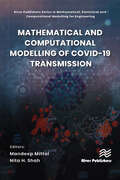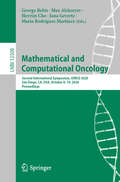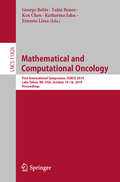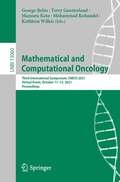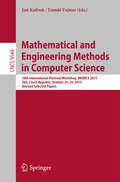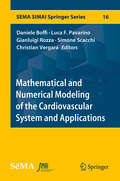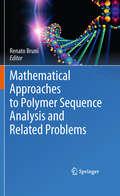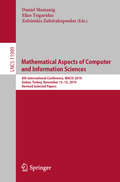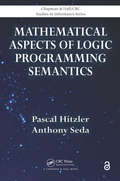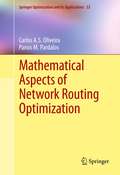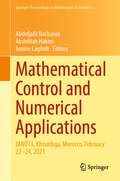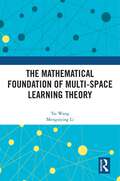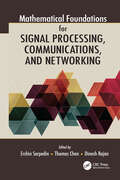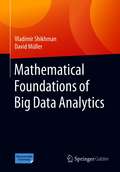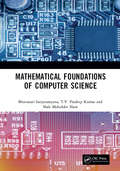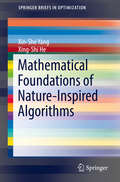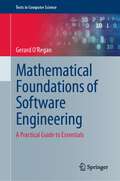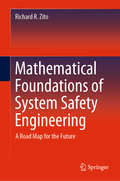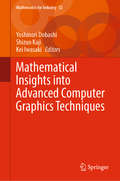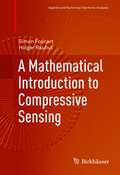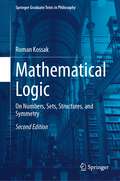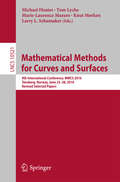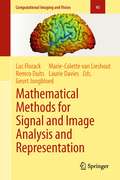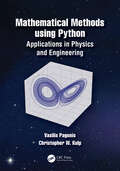- Table View
- List View
Mathematical and Computational Modelling of Covid-19 Transmission (River Publishers Series in Mathematical, Statistical and Computational Modelling for Engineering)
by Nita H. ShahInfectious diseases are leading threats and are of highest risk to the human population globally. Over the last two years, we saw the transmission of Covid-19. Millions of people died or were forced to live with a disability. Mathematical models are effective tools that enable analysis of relevant information, simulate the related process and evaluate beneficial results. They can help to make rational decisions to lead toward a healthy society. Formulation of mathematical models for a pollution-free environment is also very important for society. To determine the system which can be modelled, we need to formulate the basic context of the model underlying some necessary assumptions. This describes our beliefs in terms of the mathematical language of how the world functions. This book addresses issues during the Covid phase and post-Covid phase. It analyzes transmission, impact of coinfections, and vaccination as a control or to decrease the intensity of infection. It also talks about the violence and unemployment problems occurring during the post-Covid period. This book will help societal stakeholders to resume normality slowly and steadily.
Mathematical and Computational Oncology: Second International Symposium, ISMCO 2020, San Diego, CA, USA, October 8–10, 2020, Proceedings (Lecture Notes in Computer Science #12508)
by George Bebis Max Alekseyev Heyrim Cho Jana Gevertz Maria Rodriguez MartinezThis book constitutes the refereed proceedings of the Second International Symposium on Mathematical and Computational Oncology, ISMCO 2020, which was supposed to be held in San Diego, CA, USA, in October 2020, but was instead held virtually due to the COVID-19 pandemic.The 6 full papers and 4 short papers presented together with 1 invited talk were carefully reviewed and selected from 28 submissions. The papers are organized in topical sections named: statistical and machine learning methods for cancer research; mathematical modeling for cancer research; general cancer computational biology; and posters.
Mathematical and Computational Oncology: First International Symposium, ISMCO 2019, Lake Tahoe, NV, USA, October 14–16, 2019, Proceedings (Lecture Notes in Computer Science #11826)
by George Bebis Takis Benos Ken Chen Katharina Jahn Ernesto LimaThis book constitutes the refereed proceedings of the First International Symposium on Mathematical and Computational Oncology, ISMCO'2019, held in Lake Tahoe, NV, USA, in October 2019. The 7 full papers presented were carefully reviewed and selected from 30 submissions. The papers are organized in topical sections named: Tumor evolvability and intra-tumor heterogeneity; Imaging and scientific visualization for cancer research; Statistical methods and data mining for cancer research (SMDM); Spatio-temporal tumor modeling and simulation (STTMS).
Mathematical and Computational Oncology: Third International Symposium, ISMCO 2021, Virtual Event, October 11–13, 2021, Proceedings (Lecture Notes in Computer Science #13060)
by George Bebis Terry Gaasterland Mamoru Kato Mohammad Kohandel Kathleen WilkieThis book constitutes the refereed proceedings of the Third International Symposium on Mathematical and Computational Oncology, ISMCO 2021, held in October 2021. Due to COVID-19 pandemic the conference was held virtually.The 3 full papers and 4 short papers presented were carefully reviewed and selected from 20 submissions. The papers are organized in topical sections named: statistical and machine learning methods for cancer research; mathematical modeling for cancer research; spatio-temporal tumor modeling and simulation; general cancer computational biology; mathematical modeling for cancer research; computational methods for anticancer drug development.
Mathematical and Engineering Methods in Computer Science
by Tomáš Vojnar Jan KofroňThis volume contains the post-conference proceedings of the 10th Doctoral Workshop on Mathematical and Engineering Methods in Computer Science, MEMICS 2015, held in Telč, Czech Republic, in October 2015. The 10 thoroughly revised full papers were carefully selected out of 25 submissions and are presented together with 3 invited papers. The topics covered include: security and safety, bioinformatics, recommender systems, high-performance and cloud computing, and non-traditional computational models (quantum computing, etc. ).
Mathematical and Numerical Modeling of the Cardiovascular System and Applications (SEMA SIMAI Springer Series #16)
by Daniele Boffi Luca F. Pavarino Gianluigi Rozza Simone Scacchi Christian VergaraThe book comprises contributions by some of the most respected scientists in the field of mathematical modeling and numerical simulation of the human cardiocirculatory system. It covers a wide range of topics, from the assimilation of clinical data to the development of mathematical and computational models, including with parameters, as well as their efficient numerical solution, and both in-vivo and in-vitro validation. It also considers applications of relevant clinical interest. This book is intended for graduate students and researchers in the field of bioengineering, applied mathematics, computer, computational and data science, and medicine wishing to become involved in the highly fascinating task of modeling the cardiovascular system.
Mathematical Approaches to Polymer Sequence Analysis and Related Problems
by Renato BruniAn edited volume describing the latest developments in approaching the problem of polymer sequence analysis, with special emphasis on the most relevant biopolymers (peptides and DNA) but not limited to them. The chapters will include peptide sequence analysis, DNA sequence analysis, analysis of biopolymers and nonpolymers, sequence alignment problems, and more.
Mathematical Aspects of Computer and Information Sciences: 8th International Conference, MACIS 2019, Gebze, Turkey, November 13–15, 2019, Revised Selected Papers (Lecture Notes in Computer Science #11989)
by Daniel Slamanig Elias Tsigaridas Zafeirakis ZafeirakopoulosThis book constitutes the refereed proceedings of the 8th International Conference on Mathematical Aspects of Computer and Information Sciences, MACIS 2019, held in Gebze, Turkey, in November 2019. The 22 revised papers and 14 short papers presented were carefully reviewed and selected from 66 submissions. The papers are organized in the following topical sections: algorithms and foundation; security and cryptography; combinatorics, codes, designs and graphs; data modeling and machine learning; tools and software track.
Mathematical Aspects of Logic Programming Semantics
by Pascal Hitzler Anthony SedaCovering the authors' own state-of-the-art research results, this book presents a rigorous, modern account of the mathematical methods and tools required for the semantic analysis of logic programs. It significantly extends the tools and methods from traditional order theory to include nonconventional methods from mathematical analysis that depend on topology, domain theory, generalized distance functions, and associated fixed-point theory. The authors closely examine the interrelationships between various semantics as well as the integration of logic programming and connectionist systems/neural networks.
Mathematical Aspects of Network Routing Optimization
by Carlos A.S. Oliveira Panos M. PardalosBefore the appearance of broadband links and wireless systems, networks have been used to connect people in new ways. Now, the modern world is connected through large-scale, computational networked systems such as the Internet. Because of the ever-advancing technology of networking, efficient algorithms have become increasingly necessary to solve some of the problems developing in this area. "Mathematical Aspects of Network Routing Optimization" focuses on computational issues arising from the process of optimizing network routes, such as quality of the resulting links and their reliability. Algorithms are a cornerstone for the understanding of the protocols underlying multicast routing. The main objective in the text is to derive efficient algorithms, with or without guarantee of approximation. Notes have been provided for basic topics such as graph theory and linear programming to assist those who are not fully acquainted with the mathematical topics presented throughout the book. "Mathematical Aspects of Network Routing Optimization" provides a thorough introduction to the subject of algorithms for network routing, and focuses especially on multicast and wireless ad hoc systems. This book is designed for graduate students, researchers, and professionals interested in understanding the algorithmic and mathematical ideas behind routing in computer networks. It is suitable for advanced undergraduate students, graduate students, and researchers in the area of network algorithms.
Mathematical Control and Numerical Applications: JANO13, Khouribga, Morocco, February 22–24, 2021 (Springer Proceedings in Mathematics & Statistics #372)
by Abdeljalil Nachaoui Abdelilah Hakim Amine LaghribThis book presents some sufficient mathematical content with expressive result. The aim of JANO13 is to bring together scientists to discuss their research in all the aspects of mathematics and their applications to different scientific discipline. The main topics of the conference is partial differential equations, mathematical control, numerical analysis and computer science. The conference is interested in recent developments on numerical analysis and real applications in computer science. The latter is viewed as a dynamic branch on the interface of mathematics and informatics that has been growing rapidly over the past several decades. However, its mathematical modelling and interpretation are still not well-explained and need much more clarifications. The main contributions of this book are to give some sufficient mathematical content with expressive results. As a growing field, it is gaining a lot of attention both in media and in the industry world, which will attract the interest of readers from different scientist disciplines.
The Mathematical Foundation of Multi-Space Learning Theory
by Tai Wang Mengsiying LiThis book explores the measurement of learning effectiveness and the optimization of knowledge retention by modeling the learning process and building the mathematical foundation of multi-space learning theory.Multi-space learning is defined in this book as a micro-process of human learning that can take place in more than one space, with the goal of effective learning and knowledge retention. This book models the learning process as a temporal sequence of concept learning, drawing on established principles and empirical evidence. It also introduces the matroid to strengthen the mathematical foundation of multi-space learning theory and applies the theory to vocabulary and mathematics learning, respectively. The results show that, for vocabulary learning, the method can be used to estimate the effectiveness of a single learning strategy, to detect the mutual interference that might exist between learning strategies, and to predict the optimal combination of strategies. In mathematical learning, it was found that timing is crucial in both first learning and second learning in scheduling optimization to maximize the intersection effective interval.The title will be of interest to researchers and students in a wide range of areas, including educational technology, learning sciences, mathematical applications, and mathematical psychology.
Mathematical Foundations for Signal Processing, Communications, and Networking
by Erchin Serpedin, Thomas Chen and Dinesh RajanMathematical Foundations for Signal Processing, Communications, and Networking describes mathematical concepts and results important in the design, analysis, and optimization of signal processing algorithms, modern communication systems, and networks. Helping readers master key techniques and comprehend the current research literature, the book offers a comprehensive overview of methods and applications from linear algebra, numerical analysis, statistics, probability, stochastic processes, and optimization. From basic transforms to Monte Carlo simulation to linear programming, the text covers a broad range of mathematical techniques essential to understanding the concepts and results in signal processing, telecommunications, and networking. Along with discussing mathematical theory, each self-contained chapter presents examples that illustrate the use of various mathematical concepts to solve different applications. Each chapter also includes a set of homework exercises and readings for additional study. This text helps readers understand fundamental and advanced results as well as recent research trends in the interrelated fields of signal processing, telecommunications, and networking. It provides all the necessary mathematical background to prepare students for more advanced courses and train specialists working in these areas.
Mathematical Foundations of Big Data Analytics
by Vladimir Shikhman David MüllerIn this textbook, basic mathematical models used in Big Data Analytics are presented and application-oriented references to relevant practical issues are made. Necessary mathematical tools are examined and applied to current problems of data analysis, such as brand loyalty, portfolio selection, credit investigation, quality control, product clustering, asset pricing etc. – mainly in an economic context. In addition, we discuss interdisciplinary applications to biology, linguistics, sociology, electrical engineering, computer science and artificial intelligence. For the models, we make use of a wide range of mathematics – from basic disciplines of numerical linear algebra, statistics and optimization to more specialized game, graph and even complexity theories. By doing so, we cover all relevant techniques commonly used in Big Data Analytics.Each chapter starts with a concrete practical problem whose primary aim is to motivate the study of a particular Big Data Analytics technique. Next, mathematical results follow – including important definitions, auxiliary statements and conclusions arising. Case-studies help to deepen the acquired knowledge by applying it in an interdisciplinary context. Exercises serve to improve understanding of the underlying theory. Complete solutions for exercises can be consulted by the interested reader at the end of the textbook; for some which have to be solved numerically, we provide descriptions of algorithms in Python code as supplementary material.This textbook has been recommended and developed for university courses in Germany, Austria and Switzerland.
Mathematical Foundations of Computer Science
by Bhavanari Satyanarayana T.V. Pradeep Kumar Shak Mohiddin ShawPlease note: Taylor & Francis does not sell or distribute the Hardback in India, Pakistan, Nepal, Bhutan, Bangladesh and Sri Lanka
Mathematical Foundations of Nature-Inspired Algorithms (SpringerBriefs in Optimization)
by Xin-She Yang Xing-Shi HeThis book presents a systematic approach to analyze nature-inspired algorithms. Beginning with an introduction to optimization methods and algorithms, this book moves on to provide a unified framework of mathematical analysis for convergence and stability. Specific nature-inspired algorithms include: swarm intelligence, ant colony optimization, particle swarm optimization, bee-inspired algorithms, bat algorithm, firefly algorithm, and cuckoo search. Algorithms are analyzed from a wide spectrum of theories and frameworks to offer insight to the main characteristics of algorithms and understand how and why they work for solving optimization problems. In-depth mathematical analyses are carried out for different perspectives, including complexity theory, fixed point theory, dynamical systems, self-organization, Bayesian framework, Markov chain framework, filter theory, statistical learning, and statistical measures. Students and researchers in optimization, operations research, artificial intelligence, data mining, machine learning, computer science, and management sciences will see the pros and cons of a variety of algorithms through detailed examples and a comparison of algorithms.
Mathematical Foundations of Software Engineering: A Practical Guide to Essentials (Texts in Computer Science)
by Gerard O'ReganThis textbook presents an introduction to the mathematical foundations of software engineering. It presents the rich applications of mathematics in areas such as error-correcting codes, cryptography, the safety and security critical fields, the banking and insurance fields, as well as traditional engineering applications. Topics and features: Addresses core mathematics for critical thinking and problem solving Discusses propositional and predicate logic and various proof techniques to demonstrate the correctness of a logical argument. Examines number theory and its applications to cryptography Considers the underlying mathematics of error-correcting codes Discusses graph theory and its applications to modelling networks Reviews tools to support software engineering mathematics, including automated and interactive theorem provers and model checking Discusses financial software engineering, including simple and compound interest, probability and statistics, and operations research Discusses software reliability and dependability and explains formal methods used to derive a program from its specification Discusses calculus, matrices, vectors, complex numbers, and quaternions, as well as applications to graphics and robotics Includes key learning topics, summaries, and review questions in each chapter, together with a useful glossary This practical and easy-to-follow textbook/reference is ideal for computer science students seeking to learn how mathematics can assist them in building high-quality and reliable software on time and on budget. The text also serves as an excellent self-study primer for software engineers, quality professionals, and software managers.
Mathematical Foundations of System Safety Engineering: A Road Map for the Future
by Richard R. ZitoThis graduate-level textbook elucidates low-risk and fail-safe systems in mathematical detail. It addresses, in particular, problems where mission-critical performance is paramount, such as in aircraft, missiles, nuclear reactors and weapons, submarines, and many other types of systems where “failure” can result in overwhelming loss of life and property. The book is divided into four parts: Fundamentals, Electronics, Software, and Dangerous Goods. The first part on Fundamentals addresses general concepts of system safety engineering that are applicable to any type of system. The second part, Electronics, addresses the detection and correction of electronic hazards. In particular, the Bent Pin Problem, Sneak Circuit Problem, and related electrical problems are discussed with mathematical precision. The third part on Software addresses predicting software failure rates as well as detecting and correcting deep software logical flaws (called defects). The fourth part on Dangerous Goods presents solutions to three typical industrial chemical problems faced by the system safety engineer during the design, storage, and disposal phases of a dangerous goods’ life cycle.
Mathematical Insights into Advanced Computer Graphics Techniques (Mathematics for Industry #32)
by Yoshinori Dobashi Shizuo Kaji Kei IwasakiThis book presents cutting-edge developments in the advanced mathematical theories utilized in computer graphics research – fluid simulation, realistic image synthesis, and texture, visualization and digital fabrication. A spin-off book from the International Symposium on Mathematical Progress in Expressive Image Synthesis in 2016 and 2017 (MEIS2016/2017) held in Fukuoka, Japan, it includes lecture notes and an expert introduction to the latest research presented at the symposium. The book offers an overview of the emerging interdisciplinary themes between computer graphics and driven mathematic theories, such as discrete differential geometry. Further, it highlights open problems in those themes, making it a valuable resource not only for researchers, but also for graduate students interested in computer graphics and mathematics.
A Mathematical Introduction to Compressive Sensing (Applied and Numerical Harmonic Analysis)
by Holger Rauhut Simon FoucartFilling a significant gap in the literature, A Mathematical Introduction to Compressive Sensing is the first work entirely devoted to the thriving field of compressive sensing. The book clearly and comprehensively presents the essential theory of compressive sensing from a mathematical perspective. Featuring a substantial number of exercises with hints to solutions, as well as MATLAB codes for algorithms and simulations, the work is well suited for graduate courses on the subject. With only moderate mathematical prerequisites, this volume is a reliable resource for graduate students, practioners, and researchers in engineering, computer science, and mathematics looking to acquire a careful understanding of compressive sensing.
Mathematical Logic: On Numbers, Sets, Structures, and Symmetry (Springer Graduate Texts in Philosophy #4)
by Roman KossakThis textbook is a second edition of the successful, Mathematical Logic: On Numbers, Sets, Structures, and Symmetry. It retains the original two parts found in the first edition, while presenting new material in the form of an added third part to the textbook. The textbook offers a slow introduction to mathematical logic, and several basic concepts of model theory, such as first-order definability, types, symmetries, and elementary extensions. Part I, Logic Sets, and Numbers, shows how mathematical logic is used to develop the number structures of classical mathematics. All necessary concepts are introduced exactly as they would be in a course in mathematical logic; but are accompanied by more extensive introductory remarks and examples to motivate formal developments. The second part, Relations, Structures, Geometry, introduces several basic concepts of model theory, such as first-order definability, types, symmetries, and elementary extensions, and shows how they are usedto study and classify mathematical structures. The added Part III to the book is closer to what one finds in standard introductory mathematical textbooks. Definitions, theorems, and proofs that are introduced are still preceded by remarks that motivate the material, but the exposition is more formal, and includes more advanced topics. The focus is on the notion of countable categoricity, which analyzed in detail using examples from the first two parts of the book. This textbook is suitable for graduate students in mathematical logic and set theory and will also be of interest to mathematicians who know the technical aspects of the subject, but are not familiar with its history and philosophical background.
Mathematical Methods for Curves and Surfaces
by Michael Floater Tom Lyche Marie-Laurence Mazure Knut Mørken Larry L. SchumakerContains a carefully edited selection of papers that were presented at the Symposium on Trends in Approximation Theory, held in May 2000, and at the Oslo Conference on Mathematical Methods for Curves and Surfaces, held in July 2000. Mathematical Methods for Curves and Surfaces covers topics such as B#65533;zier curves, conic sections, offsets, and wavelets.
Mathematical Methods for Signal and Image Analysis and Representation (Computational Imaging and Vision #41)
by Luc Florack Marie-Colette van Lieshout Remco Duits Geurt Jongbloed Laurie DaviesMathematical Methods for Signal and Image Analysis and Representation presents the mathematical methodology for generic image analysis tasks. In the context of this book an image may be any m-dimensional empirical signal living on an n-dimensional smooth manifold (typically, but not necessarily, a subset of spacetime). The existing literature on image methodology is rather scattered and often limited to either a deterministic or a statistical point of view. In contrast, this book brings together these seemingly different points of view in order to stress their conceptual relations and formal analogies.Furthermore, it does not focus on specific applications, although some are detailed for the sake of illustration, but on the methodological frameworks on which such applications are built, making it an ideal companion for those seeking a rigorous methodological basis for specific algorithms as well as for those interested in the fundamental methodology per se.Covering many topics at the forefront of current research, including anisotropic diffusion filtering of tensor fields, this book will be of particular interest to graduate and postgraduate students and researchers in the fields of computer vision, medical imaging and visual perception.
Mathematical Methods for Signal and Image Analysis and Representation
by Luc Florack Marie-Colette van Lieshout Remco Duits Geurt Jongbloed Laurie DaviesMathematical Methods for Signal and Image Analysis and Representation presents the mathematical methodology for generic image analysis tasks. In the context of this book an image may be any m-dimensional empirical signal living on an n-dimensional smooth manifold (typically, but not necessarily, a subset of spacetime). The existing literature on image methodology is rather scattered and often limited to either a deterministic or a statistical point of view. In contrast, this book brings together these seemingly different points of view in order to stress their conceptual relations and formal analogies. Furthermore, it does not focus on specific applications, although some are detailed for the sake of illustration, but on the methodological frameworks on which such applications are built, making it an ideal companion for those seeking a rigorous methodological basis for specific algorithms as well as for those interested in the fundamental methodology per se. Covering many topics at the forefront of current research, including anisotropic diffusion filtering of tensor fields, this book will be of particular interest to graduate and postgraduate students and researchers in the fields of computer vision, medical imaging and visual perception.
Mathematical Methods using Python: Applications in Physics and Engineering
by Vasilis Pagonis Christopher Wayne KulpThis advanced undergraduate textbook presents a new approach to teaching mathematical methods for scientists and engineers. It provides a practical, pedagogical introduction to utilizing Python in Mathematical and Computational Methods courses. Both analytical and computational examples are integrated from its start. Each chapter concludes with a set of problems designed to help students hone their skills in mathematical techniques, computer programming, and numerical analysis. The book places less emphasis on mathematical proofs, and more emphasis on how to use computers for both symbolic and numerical calculations. It contains 182 extensively documented coding examples, based on topics that students will encounter in their advanced courses in Mechanics, Electronics, Optics, Electromagnetism, Quantum Mechanics etc.An introductory chapter gives students a crash course in Python programming and the most often used libraries (SymPy, NumPy, SciPy, Matplotlib). This is followed by chapters dedicated to differentiation, integration, vectors and multiple integration techniques. The next group of chapters covers complex numbers, matrices, vector analysis and vector spaces. Extensive chapters cover ordinary and partial differential equations, followed by chapters on nonlinear systems and on the analysis of experimental data using linear and nonlinear regression techniques, Fourier transforms, binomial and Gaussian distributions. The book is accompanied by a dedicated GitHub website, which contains all codes from the book in the form of ready to run Jupyter notebooks. A detailed solutions manual is also available for instructors using the textbook in their courses.Key Features:· A unique teaching approach which merges mathematical methods and the Python programming skills which physicists and engineering students need in their courses.· Uses examples and models from physical and engineering systems, to motivate the mathematics being taught.· Students learn to solve scientific problems in three different ways: traditional pen-and-paper methods, using scientific numerical techniques with NumPy and SciPy, and using Symbolic Python (SymPy).Vasilis Pagonis is Professor of Physics Emeritus at McDaniel College, Maryland, USA. His research area is applications of thermally and optically stimulated luminescence. He taught courses in mathematical physics, classical and quantum mechanics, analog and digital electronics and numerous general science courses. Dr. Pagonis’ resume lists more than 200 peer-reviewed publications in international journals. He is currently associate editor of the journal Radiation Measurements. He is co-author with Christopher Kulp of the undergraduate textbook “Classical Mechanics: a computational approach, with examples in Python and Mathematica” (CRC Press, 2020). He has also co-authored four graduate-level textbooks in the field of luminescence dosimetry, and most recently published the book “Luminescence Signal analysis using Python” (Springer, 2022).Christopher Kulp is the John P. Graham Teaching Professor of Physics at Lycoming College. He has been teaching undergraduate physics at all levels for 20 years. Dr. Kulp’s research focuses on modelling complex systems, time series analysis, and machine learning. He has published 30 peer-reviewed papers in international journals, many of which include student co-authors. He is also co-author of the undergraduate textbook “Classical Mechanics: a computational approach, with examples in Python and Mathematica” (CRC Press, 2020).
